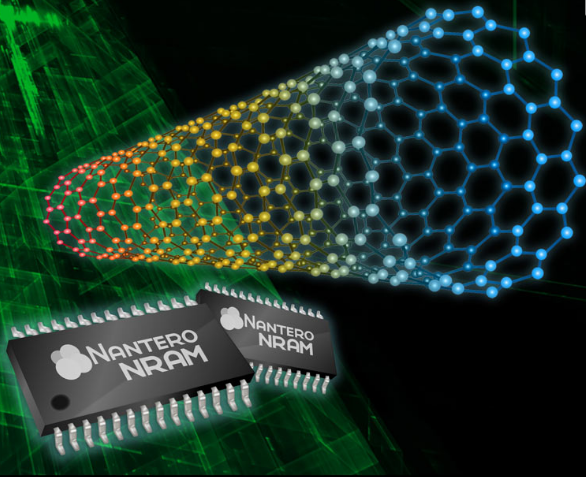By Brian Santo, contributing writer
Nantero appears to be pulling away from the pack of companies that are exploring potential successors to silicon storage with a new class of memory devices it calls nanoRAM. Non-volatile random access memory (NRAM) is based on carbon nanotubes (CNTs).

Image source: Nantero.
When interest in carbon nanotubes was revived in the early 1990s, it was understood that CNTs might make good semiconductors. That initial excitement was rekindled in 2004, when CNTs were discovered to exhibit electron mobility far superior to silicon. At the time, indications were that circuitry based on CNTs could be easily assembled with little regard for impurities. That all lead to speculation that CNTs could replace silicon relatively quickly.
That excitement early in the century was followed by more than a decade of disappointment. It turns out that the assumption that impurities were barely relevant was wrong. It was discovered that impurities had to be reduced to 10 parts per billion, according to Nantero, as reported by IEEE Spectrum. The company now has patented processing technology that gets impurities down to 1 part per billion.
The setback in processing gave the company time to conduct research in semiconductor technology. Nantero’s original semiconductor device had three terminals, one of them for switching. The company eventually devised a two-terminal device, which was not only inherently smaller but is also subject to scaling down in size. Furthermore, Nantero developed a way to assemble nanotubes on silicon.
This allows Nantero to make use of transistors on the silicon substrate as drivers. As important, if not more so, Nantero’s CNT-based devices can be fabricated on standard CMOS production equipment. This is a tremendous advantage, as semiconductor manufacturers will have to do minimal, if any, retooling. Keep in mind that it costs more to build a leading-edge fab than the GDPs of several dozen countries.
Though CNTs are exotic, NRAMs should behave a little different from any other random access memory, such as flash memory or ferroelectric RAM.
In fact, flash appears to be approaching a wall in terms of density (FRAM is, too, but it always has been a niche product). Flash vendors are searching for a potential replacement.
It turns out that NRAM could be that replacement. Like flash, NRAM is nonvolatile. Nantero believes that NRAM will be able to match the densities of current flash memories and said that, theoretically, it could be made far denser than that.
Because NRAMs will be based on carbon, which is cheap, and use standard CMOS production equipment processes (which won’t add much in the way of cost), NRAM is almost certain to be relatively inexpensive.
Nantero announced a set of products aimed at applications that might otherwise have used flash. They include the following:
- A multi-gigabyte DDR4-compatible nonvolatile standalone memory
- A standalone chip designed as a cache for solid-state drives (SSDs) or hard disk drives (HDDs)
- A line of embedded memories
Nantero said that its DDR4-like product will have speed comparable to DRAM at a lower price per gigabyte. (DDR4 is a double-data-rate fourth-generation synchronous dynamic random-access memory, or SDRAM.)
The cache, based on nonvolatile technology, will remove the need for battery backup. Nantero said that this allows for a dramatic expansion of cache size, substantially speeding up the SSD or HDD.
Embedded memory will eventually be able to scale to 5 nm in size (the most advanced semiconductors are being produced at the 10-nm and 7-nm nodes); operate at DRAM-like speeds, and operate at very high temperature, said Nantero. The company said that the embedded memory devices will be well-suited for several IoT applications, including automotive.
CNT has disappointed before, but there are signs that this time around, Nantero might come through. Recently, some of the world’s biggest industrial companies invested in Nantero, including Dell, Cisco, Kingston Technology, Schlumberger, and three “global” semiconductor manufacturers that Nantero won’t name yet.
Most encouraging, however, may be that Fujitsu licensed Nantero’s technology. Fujitsu also is co-developing the technology and has agreed to act as a foundry. Fujitsu expects to introduce NRAM embedded LSI in mass production in 2019, an extraordinary claim to make if it wasn’t confident that it can deliver.
In a video discussing NRAM technology, Matsumiya Masato, Fujitsu vice president, head of the company’s system memory operation, said that Fujitsu is preparing to mass-produce NRAMs in 2019 using a 55-nm process. Masato explained that NRAMs share the very fast write times and low power consumption of FRAM with similar write endurance, but NRAM is also robust at high temperatures. He said that if NRAM read/write density and memory density is improved, NRAM could replace DRAM.
There are many alternative memory proposals with promise, but Nantero appears to have been able to reap CNT’s potential while putative rivals are still doing basic R&D on various materials and device architectures.
Silicon hasn’t hit a dead end yet. Intel’s 3D XPoint SSDs are hailed as some of the fastest memory available. But the manufacturing process is complicated and the devices are expensive.
The number of possible alternatives to common silicon-based memory is boggling. Some are based on different materials; others on different architectures; some on both. They include a magnetic RAM based on gadolinium and iron; a new, unspecified ferroelectric material that is one of the first in its category to exhibit all of the characteristics useful for computer memory; and diselenides and molybdenite.
One new approach is vacuum-channel transistors; another is embedding semiconductors with nanostructures. And then there is a fairly well-stocked category of possible devices based on exotic physics phenomena, such as quantum bits (Qbits), nanoscale optical quantum effects, and skyrmions.
Any or all of these technologies could eventually prove to be commercially viable, but most of them are at the stage at which researchers are still characterizing the basic physics.
Advertisement
Learn more about Electronic Products Magazine





